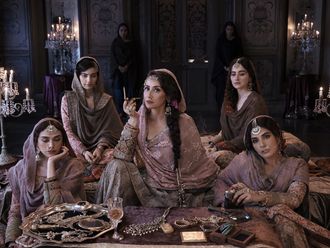On Stalin’s Team
By Sheila Fitzpatrick, Princeton University Press, 384 pages, $35
“Team” is not the definition I would use for a group of 40 to 50 people (almost entirely men) who, at their captain’s bidding, colluded in murdering over half their fellow members; nor does “team” fit men selected more for their incompetence than their ability as leaders, administrators or planners.
In her introduction to this superbly researched, intelligent book, Sheila Fitzpatrick concedes this, inviting readers to substitute the word “gang” if they prefer. Even “gang” is too bland for these “scorpions in a jar”, as observers of the infighting put it. Perhaps “henchmen” is the word.
Two myths lie behind Stalin’s rehabilitation in Russia. One is that he won the Second World (or “great patriotic”) War — though many historians conclude that the Russian people, helped by generous US supplies, won despite Stalin’s vacillation between inaction and wasteful enterprise. The other myth is that of Stalin as a great personnel manager.
Although Fitzpatrick often notes the “energy” and “efficiency” with which Stalin’s men approached their remits, she perhaps underplays the appalling uselessness of those remits: in the early 1930s, shooting, starving, freezing or working to death 10 million peasants; in the Great Terror of 1937-38, executing some 700,000 people and sending two million to die in the gulag, among them the Soviet Union’s most accomplished citizens — technologists, scientists, artists — then decapitating the army by shooting most of the senior officers; and in 1944, while war still raged, dispatching more than a million people of “traitor” nationalities to the deserts of Central Asia.
Stalin’s “team” members certainly worked long hours, mostly at night, and trembled with fear lest their leader find them underachieving — but a more counterproductive way of governing a state would be hard to imagine.
Let us look at the permanent, core team members — known to Stalin from the revolution, who went on to die of old age in their beds. Stalin’s criteria for choosing his team were certainly original: he often took men who had blotched escutcheons — services to the tsars, acts of treachery or cowardice — because it made them blackmailable. One instance is his chief show-trial prosecutor, Andrei Vyshinsky. He chose not the alpha but the omega males, who could not possibly be employed by, or loyal to, any of Stalin’s rivals: Kliment Voroshilov was the worst marshal in the Soviet army (and he knew it: when the others were arrested, he told the equally dimwitted Marshal Budionny, “Don’t worry: they’re only arresting the clever ones”).
Vyacheslav Molotov, who was Stalin’s chief executive in the 1930s and — when a common language had to be found with Hitler — foreign minister, was the worst such appointment in the history of diplomacy. He worked hard and loyally, in the mid-1930s typically perusing the lists of 44,000 people whose executions were sanctioned by the politburo and scribbling “Prostitute, scum, death penalty” against their names. (It helped that his initials, VM, also stood for “highest penalty”, i.e. death by shooting.)
Lazar Kaganovich may seem more remarkable: he was the token Jew in a politburo from which, as the revolutionary Karl Radek joked, Stalin had removed the Jews, like Moses removing them from Egypt; the efficient Moscow metro was built under his supervision.
Anastas Mikoyan had a greasy charm and gave furtive help to victims of Stalinism.
Fitzpatrick omits mention of Stalin’s worst “fixer”, the indestructible Lev Mekhlis, whose interventions in the war probably cost half a million lives. These men had less team spirit than Hitler’s gangsters (few of whom, no matter how disloyal or incompetent, were repressed by Hitler). No historian talks of Hitler’s “team”.
Apart from torturing and then shooting (or driving to suicide) his associates, Stalin had another method for controlling poets, musicians, scientists and ministers he thought better kept alive: to take one of their relatives hostage. Thus head of state Mikhail Kalinin had a wife who spent decades in a bathhouse in Kazakhstan, delousing prisoners’ underwear; and Molotov’s wife, after having greeted the Israeli ambassador Golda Meir effusively, also ended up in the gulag.
Sometimes the team anticipated Stalin’s measures: Kaganovich made his elder brother kill himself; Nikolai Ezhov did the same to his wife. Stalin controlling his ministers is like the Chinese dowager empress Tzu-Hsi (Cixi) whose ministers had to present their genitals for inspection — in a glass jar.
Just as today Putin reminds us “there are no ex-secret policemen”, so Stalin’s team had no provision for resignation or retirement. Even former ministers of the tsarist or other anti-Bolshevik regimes could find safe new jobs in the USSR: the best being a morgue, one workplace in the USSR where nobody was accused of sabotage.
Under Stalin, even if, like the doomed Nikolai Bukharin, you had a hinterland and some humane instincts, there was no relenting: your family were the “cogs in the machine” that ensured you kept working.
One of Fitzpatrick’s most interesting sections is her final chapter, “Without Stalin”. It covers a period during which the team reduced the number of internecine murders, introduced amnesties and admitted errors. Yet, under Khrushchev, executions (for speculation or industrial action) were undiminished. The only team member who attempted any radical turnaround was the vilest of murderers, Lavrenti Beria. In his 100 days of power from March to June 1953, there were no executions: only proposed reforms that made this priapic sadist a premature Gorbachev. Therefore the team shot him.
In other circumstances, they might have made a competent chamber ensemble: Stalin, Voroshilov and Kaganovich all sang church music; Molotov was a fair violinist; Andrei Zhdanov, the repressor of postwar culture, played the piano. There were in the early 1930s “team-bonding” outings at Stalin’s dacha in Abkhazia, where they fished (with dynamite) and barbecued sheep. But, as the helpful 50 potted biographies at the end of this book imply, alliances between members were pragmatic and short-lived, formed to oust those who threatened them and to protect themselves from Stalin’s wrath.
Fitzpatrick delved into Soviet archives a decade before anyone else, thanks to serendipity (she chose to study the one commissar, Anatoly Lunacharsky, whose archive the Soviets would open to a Westerner) and to sheer personality: she has unearthed and read more documents, interviewed more people and made more intelligent deductions than most of her fellow historians. But in this study of Stalinism there is a softness that would be unacceptable in a study of Nazism: it stems from over-familiarity with the personalities she encounters, particularly the charming grandchildren of the team.
Historians are vulnerable to Stockholm syndrome: they forgive the men who have taken them hostage. (This fascination also colours Simon Sebag Montefiore’s “Stalin: At the Court of the Red Tsar”.) The offspring of Beria, Mikoyan, Molotov and Kaganovich are loyal to their progenitors: they paint pictures of loving husbands and fathers who, if they killed, did so only to save their own families.
Nino Beria, who lived to her 90s, claimed that her husband’s hundreds of female visitors were just “agents doing their duty”, while Beria’s son Sergo portrayed his father as the Albert Speer, not the Heinrich Himmler of Stalin’s team. They all lie. We should remember that commandants of Nazi extermination camps, too, loved their children and listened to Schubert: that mitigates nothing.
Varlam Shalamov, who spent 20 years in Kolyma, the worst of the gulags, and was one of few able to write about his stay in hell, decided that the worst aspect of Russian character, all the more so of intellectuals, artists and scientists, was their uncritical sycophancy whenever faced with the brutal figure of a semi-literate secret police chief. Historians should remember this. Stalin’s team were like Komodo dragons: whether they kiss you or bite you, you die of their poison.
–Guardian News & Media Ltd
Donald Rayfield’s books include “Stalin and His Hangmen and Edge of Empire — A History of Georgia”.









